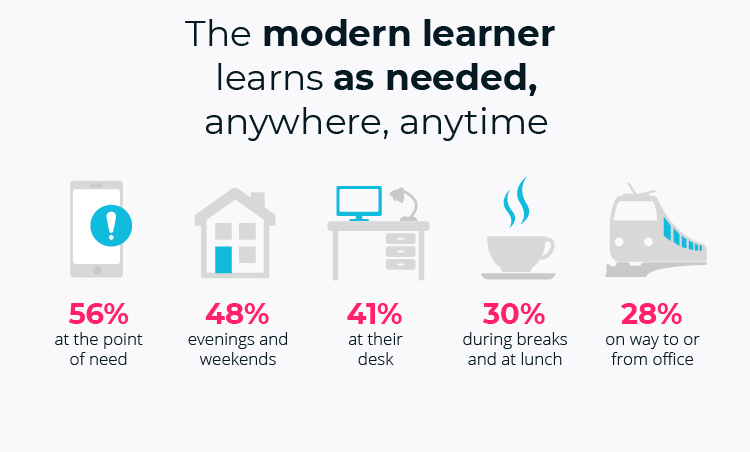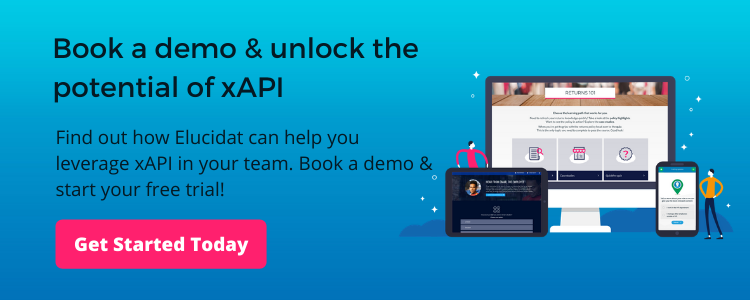SCORM vs Tin Can (xAPI)
6 minute read
The decision about which content standards to use when producing corporate elearning content will affect the longevity of your content and systems. Whilst SCORM is the most widely used digital learning standard, xAPI opens up a wealth of opportunity for tracking, personalizing and improving learning experiences, so if you’re comparing SCORM vs Tin Can xAPI, look no further…

Both SCORM and Tin Can – now more commonly known as xAPI – are communications protocols for tracking learning related activity. They provide a framework and structure to pass data and information between learning content and technologies. But the extent and flexibility to which SCORM and xAPI are able to do this differs significantly.
What is SCORM?
SCORM (which stands for Sharable Content Object Reference Model), was originally developed in 1999. Back then, elearning content could only be used on one system because different technologies didn’t have a way of speak to one another to pass across information reliably. So, a new protocol was established for tracking learning activity… SCORM.
To explore SCORM in greater detail, check out our detailed guide in our post: What Is SCORM?
3 key benefits of SCORM to consider
SCORM offers a reliable and established tracking solution for elearning that has been widely adopted by many organizations. While it may have limitations when it comes to tracking modern learning experiences, it remains a popular choice for many elearning providers and organizations. Here are 3 core benefits:
- Practicality: SCORM is designed to be practical, meaning that it can work seamlessly with different LMSs and authoring tools. This makes it easier to create and deliver elearning content across different platforms, without having to worry about compatibility issues.
- Standardization: SCORM is a widely recognized and accepted standard for elearning content. This means that it’s easier to create and share content across different organizations, as long as they use a compatible LMS or authoring tool. This can save time and resources, as you don’t need to create customized content for each organization.
- Cost-effective: SCORM is a cost-effective solution for elearning, as it’s widely available and supported by many LMS and authoring tool vendors. This means that you don’t need to invest in expensive proprietary solutions, and can instead focus on creating quality content that can be used across different platforms.
SCORM didn’t age well
As a content standard for corporate elearning, SCORM was revolutionary in enabling organizations to deliver and track learning taking place within the LMS. But, today learning happens everywhere – and SCORM doesn’t offer a way to capture this information.

Which is why we are comparing SCORM vs Tin Can xAPI.
Enter xAPI…
What is xAPI?
xAPI is a corporate elearning software that collects data tracking and monitoring of the activities of learners. Since its release in April 2013, the Experience API (also known as xAPI or Tin-Can) has knocked SCORM off its long established perch. This API offers a consistent format to capture data.
Like SCORM, xAPI is a protocol for tracking learning related activity. The key difference is that xAPI allows you to track learning in almost any context, not just in the LMS.
xAPI enables the recording, tracking, personalizing and improving of learning activities, both on and offline. It offers a more nuanced picture of how people engage with blended learning experiences. And, xAPI can also be used to make direct links between people’s learning experiences and their on-the-job performance.
As well as being better defined than the SCORM API, xAPI also uses newer technologies. This makes it easier to use, more accessible to developers and more robust.
A real-life example of xAPI: Personalizing training for improved Sales performance
Imagine you want to improve the performance of your sales team by improving close rates. You’d want to know what makes the high performers so successful, and how you can train others to do the same. xAPI can help!
Understanding how to use xAPI gives you the key to unlocking an improved understanding of training success and learner progress. Using xAPI you could pull together data from a range of different sources into your LRS (Learning record store), for example:
- Pipeline performance data from your Sales CRM
- Elearning engagement data from scenario-based sales assessments
- Data from call listening and coaching sessions
Together, these pieces of data can paint the bigger picture, helping you to identify specific training needs. For example, you could trigger a learning intervention based on a rep losing three sales in a row. xAPI helps you to catch potential issues early on.
Check out 3 more examples of xAPI being used to deliver learning with real-life impact.
Five benefits of xAPI compared to SCORM
If you are considering xAPI over SCORM, you likely already have a Learning Record Store (LRS) in place.
Compared to SCORM, xAPI is more versatile and flexible, as it can track learning experiences from various sources such as mobile devices, simulations, games, and even real-world experiences into your LRS. Here are some of the core benefits:
- Flexibility: xAPI better reflects modern learning experiences that happen anywhere, at any time.
- Tracking: xAPI gives richer insights that will allow you to identify and understand learner behavior, and how your learning content is performing and can be improved.
- Personalized Learning: With xAPI, you can track individual learner progress, identify their unique learning needs, and personalize learning experiences accordingly. This can lead to better engagement, higher retention rates, and improved performance outcomes.
- Scalability: As your elearning offering grows, xAPI can scale with it. It can handle large amounts of data from different sources and provide a centralized repository for all your learning data, making it easier to manage and analyze.
- Future-proof: xAPI is designed to be future-proof, meaning that it can adapt to new technologies and learning experiences as they emerge. This allows you to stay ahead of the curve and provide innovative learning experiences to your learners.
Some limitations of using xAPI instead of SCORM:
- Implementation: Implementing xAPI can be more complex compared to SCORM, as it requires a deeper understanding of the technical specifications and protocols involved. This may require additional resources and expertise.
- Compatibility: While xAPI is designed to be practical, not all LMS and authoring tools support it. This may limit the ability of certain platforms, especially those that rely on SCORM-based solutions.
- Learning Curve: Switching from SCORM to xAPI may require some learning curve for users and administrators who are not familiar with the new standard. This may lead to resistance and reluctance to adopt the new technology, which can impact the overall success of the e-learning program.
Ultimately, the choice between xAPI and SCORM will depend on the specific needs and goals of the organization, as well as the technical capabilities and resources available.
Sometimes it doesn’t have to be a choice either. Elucidat allows you to create courses that can both be hosted as a SCORM course on an LMS but also send xAPI tracking data to an LRS. So the same course can be SCORM and xAPI compatible, best of both worlds.
What can you track? SCORM vs Tin Can xAPI
As mentioned, xAPI enables you to capture a far richer picture of learning taking place than SCORM. The table below gives you an overview.
[su_table]
SCORM |
xAPI |
|
| Completion | ✔ | ✔ |
| Time | ✔ | ✔ |
| Pass/Fail | ✔ | ✔ |
| A single score | ✔ | ✔ |
| Multiple scores | ✔ | |
| Detailed test results | ✔ | |
| Games & simulations | ✔ | |
| Informal learning | ✔ | |
| Real-world performance | ✔ | |
| Offline learning | ✔ | |
| Interactive learning | ✔ | |
| Adaptive learning | ✔ | |
| Blended learning | ✔ | |
| Long-term learning | ✔ | |
| Team-based learning | ✔ |
[/su_table]
Leveraging xAPI in your learning team
xAPI opens up a world of possibilities for delivering people-centered elearning because it gives you the opportunity to much better understand learning behavior and the effectiveness of learning experiences.
Are your learning technologies xAPI enabled?
Modern digital learning technologies, like Elucidat’s authoring platform, are built with xAPI at the heart in order to enable integration with other systems and to support customers in taking a data driven approach to learning. This will enable you to connect the dots and perfect your digital learning strategy.
Making sure your team has the right tools for the job is fundamental.
What would you love to know about your audience?
The chances are you could be getting a whole lot more insight about your learning programs and delivering a whole lot more impact than you do right now.
So, get together with your team and start discussing what additional insight you’d love to have about your learners and learning programs. It’s likely that xAPI can help!
Do you want to make data-driven learning part of your team’s day-to-day?
Download the free Everyday Guide to Learning Analytics – by Lori Niles-Hofmann and Kirstie Greany



